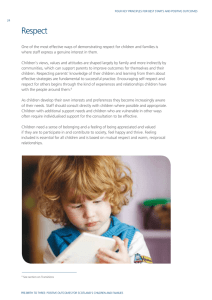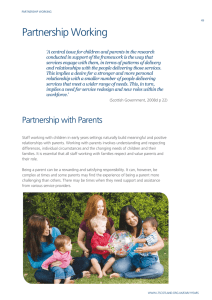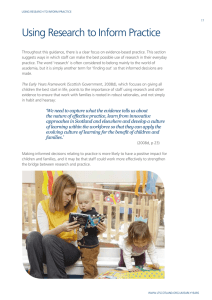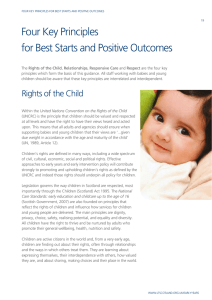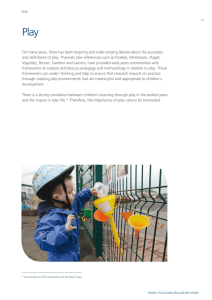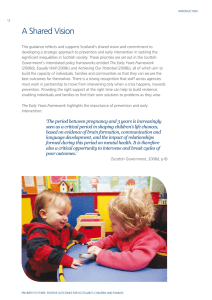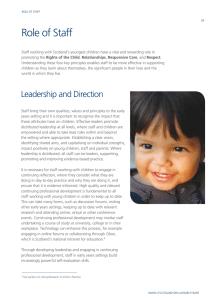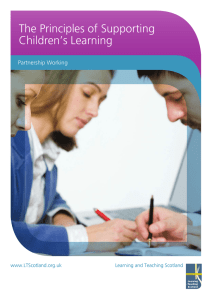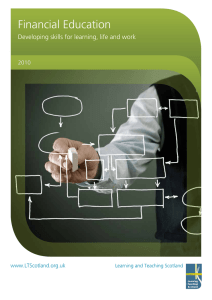Observation, Assessment & Planning in Early Years
advertisement
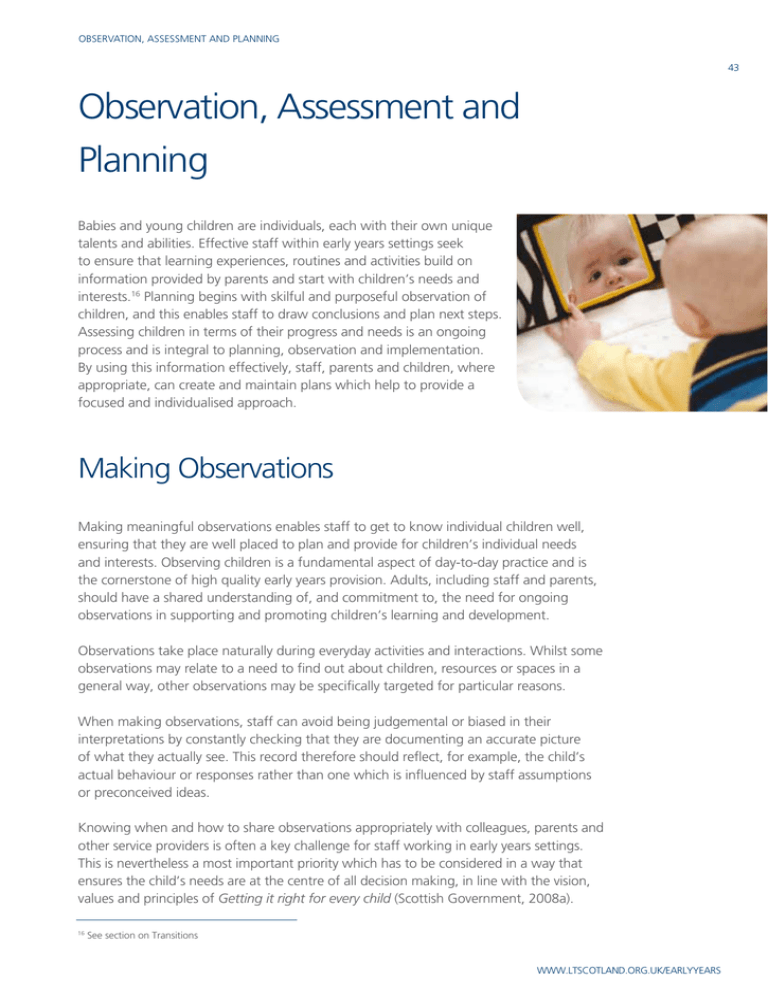
observation, assessment and planning 43 Observation, Assessment and Planning Babies and young children are individuals, each with their own unique talents and abilities. Effective staff within early years settings seek to ensure that learning experiences, routines and activities build on information provided by parents and start with children’s needs and interests.16 Planning begins with skilful and purposeful observation of children, and this enables staff to draw conclusions and plan next steps. Assessing children in terms of their progress and needs is an ongoing process and is integral to planning, observation and implementation. By using this information effectively, staff, parents and children, where appropriate, can create and maintain plans which help to provide a focused and individualised approach. Making Observations Making meaningful observations enables staff to get to know individual children well, ensuring that they are well placed to plan and provide for children’s individual needs and interests. Observing children is a fundamental aspect of day-to-day practice and is the cornerstone of high quality early years provision. Adults, including staff and parents, should have a shared understanding of, and commitment to, the need for ongoing observations in supporting and promoting children’s learning and development. Observations take place naturally during everyday activities and interactions. Whilst some observations may relate to a need to find out about children, resources or spaces in a general way, other observations may be specifically targeted for particular reasons. When making observations, staff can avoid being judgemental or biased in their interpretations by constantly checking that they are documenting an accurate picture of what they actually see. This record therefore should reflect, for example, the child’s actual behaviour or responses rather than one which is influenced by staff assumptions or preconceived ideas. Knowing when and how to share observations appropriately with colleagues, parents and other service providers is often a key challenge for staff working in early years settings. This is nevertheless a most important priority which has to be considered in a way that ensures the child’s needs are at the centre of all decision making, in line with the vision, values and principles of Getting it right for every child (Scottish Government, 2008a). 16 See section on Transitions www.LTScotland.org.uk/earlyyears observation, assessment and planning 44 Assessment Children have a key role to play in assessment and they should be encouraged to contribute to all stages as and when appropriate. Clearly, judgements about children’s involvement in the assessment process have to be based on what is developmentally appropriate and also on detailed knowledge of individual children. Assessing children in relation to their learning and development can take many different forms, for example through observations or conversations. Staff need to be very careful to ensure, however, that conclusions drawn from assessments are indeed valid and reliable. Working and communicating meaningfully and respectfully with parents, other key family members and relevant services is necessary if staff are to make valuable and accurate assessments of children as an integral part of the overall provision. PRE-BIRTH TO THREE: POSITIVE OUTCOMES FOR SCOTLAND’S CHILDREN AND FAMILIES observation, assessment and planning 45 Staff and/or parents may consider that additional intervention is required to support a child’s wellbeing, health and development. Getting it right provides staff with guidance to help ensure that children benefit from support which is appropriate, proportionate and timely.17 Staff may find the National Practice Model that joins up the Well-being Indicators and the Getting it right ‘My World Triangle’ helpful in the process of identifying concerns, gathering relevant information about children in more complex situations and analysing that information: ‘When working with children or young people the My World Triangle can be used at every stage to think about the whole world of the child or young person. It is particularly helpful to use the My World Triangle to gather more information from other sources, possibly some of it specialist, to identify the strengths and pressures in the child or young person’s world. This may include, for example, information about health or learning, offending behaviour or information about issues affecting parenting.’ (Scottish Government, 2008a, section 4) 17 See section on Partnership Working www.LTScotland.org.uk/earlyyears observation, assessment and planning 46 Recording Like assessment, recording may be a continuous process throughout the ‘observation, planning, assessment and implementation’ cycle. Records generally include observations and information from parents as well as staff and, where appropriate, children themselves. The information can be wide-ranging, depending upon the needs of individual children, and may include significant information relating to, for example, children’s development and learning, social and emotional wellbeing, likes and interests. Selecting the most appropriate and effective recording technique usually depends on the particular focus and purpose of the record itself and how it is to be used. Records may take many forms from simple note-taking to video footage, pictures, photos or individual profiles or plans. It is important to ensure that any system of recording respects confidentiality, is manageable and is not too time-consuming. Effective recording systems lead to clear records which take account of confidentiality but can be accessed readily so that they can be used, amended, added to and shared appropriately. Planning Planning is only effective when staff take account of children’s needs, dispositions, interests and stages of development. Flexible planning that assists staff to be responsive ensures that potentially rich and meaningful learning opportunities, which have not been planned, are also recognised and maximised.18 Building in time to ensure that colleagues share observations as they talk, plan and reflect together is also central to ensuring that provision for children is consistent, appropriate, caring and motivating. If overall provision is to respond meaningfully to the needs of children, planning needs to be informed by observations and regular assessment, and it has to include information from parents and other relevant professionals. The key person system19 is extremely valuable in supporting this approach to planning, as the staff who know the children and families best can ensure that discussions and decisions about needs and next steps for children are on track. 18 See section on Play 19 See section on Role of Staff PRE-BIRTH TO THREE: POSITIVE OUTCOMES FOR SCOTLAND’S CHILDREN AND FAMILIES observation, assessment and planning 47 To reflect a genuinely child-centred approach, staff need to acknowledge and value the child’s voice meaningfully in the planning process where possible. The UNCRC emphasises every child’s right to express their opinion and have that opinion taken into account. Staff should place observation, planning and assessment at the heart of their practice and this process should be seen as a continuous cycle in supporting babies and young children. Taking meaningful account of the four key principles of the Rights of the Child, Relationships, Responsive Care and Respect should ensure that staff help families to achieve the best possible start for all children. Reflection and Action – Observation, Assessment and Planning • How do you ensure that your observations are focused and that you record significant information? • Reflect on how you currently use this information and discuss the ways in which you could use it more extensively/effectively. Case Study – Observation, Assessment and Planning At a recent staff meeting, Gordon, the manager of an early years setting, was discussing observations of children’s learning. He asked members of staff to share some of the observations they had recorded that week. Whilst some members of staff said they hadn’t been able to find time to record observations, other colleagues had recorded lots of very detailed observations. Through team discussion it was agreed that there needed to be a more consistent approach. Discussion How should Gordon support the staff team so that they reach a shared understanding of the process and purposes of observational assessment? www.LTScotland.org.uk/earlyyears observation, assessment and planning 48 Signpost to Research – Observation, Assessment and Planning Many staff working with very young children are already familiar with New Zealand’s exemplary national curriculum, ‘Te Whariki’, which has been developed for children aged 0–5 years. This research paper gives an overview of the principles and framework of Te Whariki and appraises its early implementation. It goes on to discuss an action research project which trialled the use of ‘Learning and Teaching Stories’ as a user-friendly approach to assessment and self-evaluation in children’s centres. Podmore, V, and Carr, M (1999) ‘Learning and Teaching Stories: New Approaches to Assessment and Evaluation’ – ­Conference Paper, AARE – NZARE Conference on Research in Education, Melbourne, 1 Dec 1999 [online] www.aare.edu.au/99pap/pod99298.htm See also Scottish Government (2008) Growing Up in Scotland: Sweep 2 Overview Report, Chapter 5: ‘Activities with Others’. PRE-BIRTH TO THREE: POSITIVE OUTCOMES FOR SCOTLAND’S CHILDREN AND FAMILIES
